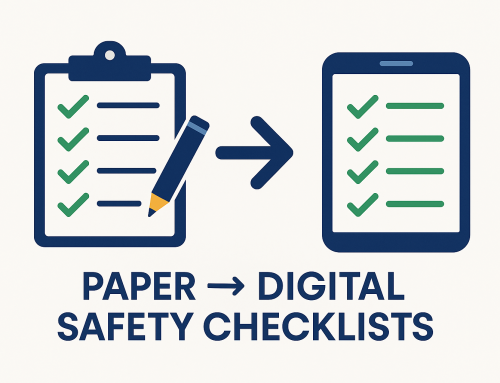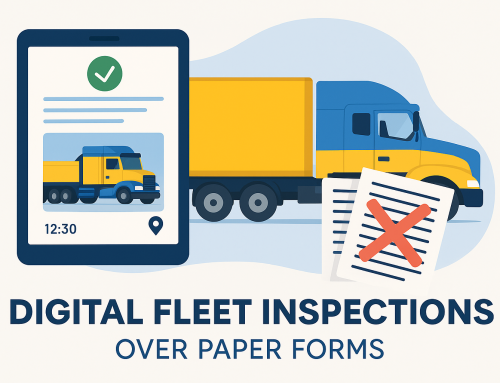Preventative Maintenance: The Complete Guide to Digital Checklists, Scheduling, and Compliance
Effective preventative maintenance keeps vehicles roadworthy, equipment reliable, and facilities safe. Yet many organisations still use paper forms or spreadsheets—slowing inspections, losing evidence, and creating weak audit trails. This guide shows how to modernise preventative maintenance with digital checklists, photo evidence, geo‑time stamping, and action tracking so you can prove safety and compliance while cutting unplanned downtime.
- Why Preventative Maintenance Matters
- How Digital Checklists Elevate Preventative Maintenance
- Preventative Maintenance for Vehicles & Fleet
- Preventative Maintenance for Equipment & Machinery
- Preventative Maintenance for Facilities & Infrastructure
- Compliance, Audit Readiness & Evidence Capture
- Paper vs Digital: A Practical Comparison
- How to Roll Out a Preventative Maintenance Program (in 30 Days)
- FAQs
- About DIGI CLIP Mobile Forms
- Conclusion
- Digitise preventative maintenance to cut defects, minimise downtime, and strengthen compliance.
- Capture photo evidence, use geo‑time stamps, and push actions to a central Action Register.
- Complete checklists on mobile—even offline. Users submit saved forms once back online; data then syncs to the cloud.
- Schedule recurring inspections and receive email alerts so nothing slips through the cracks.
- Prove what was checked, by whom, where and when—every time.
Why Preventative Maintenance Matters
Preventative maintenance (often spelled “preventive maintenance”) is the structured, proactive servicing of assets to avoid failures, extend asset life, and maintain safe operations. It’s critical across transport, warehousing, agriculture, construction, and facilities management—where a missed inspection can become a breakdown, a safety incident, or a failed audit.
- Reduce downtime: Plan inspections and interventions before faults escalate.
- Lower lifecycle costs: Keep components within warranty conditions and avoid run‑to‑failure replacements.
- Improve safety & compliance: Demonstrate due diligence with time‑stamped, evidenced records.
- Boost asset utilisation: More availability from the assets you already own.
How Digital Checklists Elevate Preventative Maintenance
With DIGI CLIP, preventative maintenance moves beyond tick‑and‑flick. Mobile forms collect rich evidence, automate alerts, and centralise actions so you can close out defects quickly and pass audits with confidence.
- Smart checklists: Standardise inspections with Yes/No/N/A, mandatory comment on “No”, and photo capture.
- Geo‑time stamping: Every submission is time‑and‑location stamped for accountability.
- Action Register: Defects become trackable actions with owners, due dates, and status.
- Offline first: Teams can complete inspections without signal and submit once connectivity returns.
- Analytics & trend spotting: Identify recurring issues, hotspots, and vendors/assets causing repeat faults.
Preventative Maintenance for Vehicles & Fleet
Vehicle reliability and roadworthiness depend on consistent preventative maintenance. Standardise daily pre‑starts, weekly checks, and scheduled services across trucks, utes, forklifts, and specialised vehicles.
What to include
- Brakes, tyres, steering & suspension
- Lights, horns, mirrors, wipers
- Fluids, battery, belts & hoses
- Load restraint & safety equipment (triangles, extinguishers, first aid)
- Temperature control for refrigerated units; door seals; airflow & defrost
Related reads: Digital Checklists for Workplace Safety · Top Benefits of Digital Inspection Apps for Compliance
Preventative Maintenance for Equipment & Machinery
From conveyors and compressors to excavators and harvesters, equipment requires routine inspection and servicing to remain safe and productive. Digital checklists ensure nothing is missed and evidence is captured.
What to include
- Pre‑start condition checks (guards, leaks, loose fittings)
- Lubrication schedules and filter changes
- Calibration and functional tests
- Emergency stops and interlocks
- Spare parts and consumables levels
See also: From Paper to Digital: Compliance Tools for SMBs
Preventative Maintenance for Facilities & Infrastructure
Buildings and sites need their own preventative maintenance rhythm—fire systems, emergency lighting, HVAC, racking, dock levellers, doors, and site signage. A single missed test can impact compliance or insurance.
- Fire extinguishers, hydrants, hose reels & emergency lighting
- HVAC filters, belts, thermostat calibration & condensate drains
- Racking inspections & load ratings
- Walkways, lighting, fencing & security
- Spill kits and environmental controls
Compliance, Audit Readiness & Evidence Capture
Regulators and auditors look for more than a signed sheet. They want proof. DIGI CLIP strengthens your position with photo evidence, geo‑time stamps, and an Action Register to demonstrate risk control and continuous improvement. For guidance, review authoritative resources such as the Safe Work Australia Code of Practice: Managing Risks of Plant and the ISO 55000:2024 - Asset management framework.
- Real‑time evidence of controls in place
- Traceability from defect to close‑out
- Downloadable PDF reports and exportable registers
- Configurable email alerts for due/overdue items
Paper vs Digital: A Practical Comparison
| Aspect | Paper / Spreadsheets | Digital with DIGI CLIP |
|---|---|---|
| Evidence | Signatures only; photos separate or missing | Photos, comments, geo‑time stamps embedded in each record |
| Defect follow‑up | Manual chasing; poor visibility | Action Register with owners, due dates, reminders, and status |
| Consistency | Varies by site/shift | Standardised templates with mandatory fields and logic |
| Access | Clipboards and folders | Mobile and web; offline completion and submit when back online |
| Audit readiness | Slow collation; gaps likely | Instant search, PDF exports, and complete audit trail |
How to Roll Out a Preventative Maintenance Program (in 30 Days)
- Inventory your assets: Vehicles, equipment, facilities. Group by type and criticality.
- Define inspection templates: Start with high‑risk assets. Include Yes/No/N/A, mandatory comments on “No”, and photo capture.
- Set schedules & ownership: Assign responsibilities, frequencies, and due dates.
- Pilot with one site/team: Collect feedback; refine templates and alerts.
- Train & launch: Short toolbox session; show mobile app basics and submission process.
- Monitor actions: Use the Action Register to drive close‑outs and measure improvements.
- Report & improve: Export registers, share wins, and address recurring defects.
Helpful Internal Resources
- Digital Checklists for Workplace Safety
- Top Benefits of Digital Inspection Apps for Compliance
- From Paper to Digital: Compliance Tools for SMBs
- DIGI CLIP Mobile Forms: Elevate Your Inspections & Safety
Preventative Maintenance FAQs
What is preventative maintenance?
Preventative maintenance is scheduled, proactive servicing of assets—vehicles, equipment, and facilities—to prevent failures, extend asset life, and keep operations safe and compliant.
How does DIGI CLIP support preventative maintenance?
DIGI CLIP provides mobile checklists with photos, mandatory comments on failed items, geo‑time stamps, and an Action Register to track defects to close‑out. You can complete forms offline and submit once back online.
Can teams complete inspections without internet?
Yes. Inspections can be completed offline. When the device regains connectivity, users submit saved forms and data syncs to the cloud.
What evidence do auditors expect?
Clear evidence of controls: photos, time/date, location, signatures, and traceability from defect to action close‑out. DIGI CLIP captures all of this in each record.
How quickly can we roll out a program?
Most teams pilot in 1–2 weeks and scale in 30 days. Start with your highest‑risk assets and standardise templates before expanding.
Does DIGI CLIP replace our CMMS?
DIGI CLIP focuses on inspections, evidence capture, and action tracking. Many customers use it alongside a CMMS, exporting registers or PDFs as needed.
About DIGI CLIP Mobile Forms
DIGI CLIP is a mobile checklist and inspection app that simplifies safety, compliance, and operational reporting. Designed for industries like transport, warehousing, agriculture, and construction, DIGI CLIP replaces paper forms with real‑time digital checklists. Built‑in photo capture, automated alerts, geo‑time stamping, and an Action Register ensure nothing gets missed.
Why Try DIGI CLIP? Because safety actions don’t count if you can’t prove them. Start your free trial—no credit card needed—and see how simple compliance can be.
Conclusion: Put Preventative Maintenance on Autopilot—With Proof
The fastest route to safer, more reliable operations is structured preventative maintenance backed by evidence. DIGI CLIP standardises inspections, captures photos and geo‑time stamps, and turns defects into actions you can track to completion—so you reduce downtime, stay audit‑ready, and keep your teams safe.
If you liked this post, why not share it!








Leave A Comment